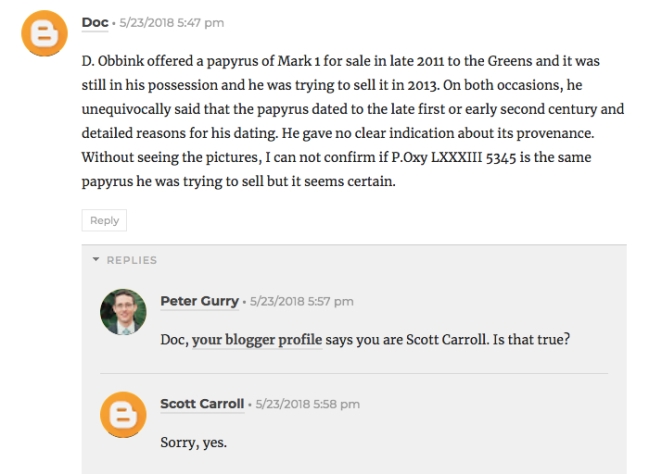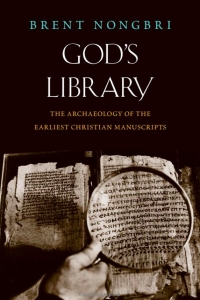Quite a bit has gone down since Elijah Hixson broke the news yesterday that a newly published Oxyrhynchus papyrus (P.Oxy. 83.5345) is the much awaited “first century Mark” fragment that has been rumored to exist since 2012. First of all, the fragment’s editors (Dirk Obbink and Daniela Colomo) assign the piece to the second or third century. So much for the supposedly sensational early date. But what is perhaps most intriguing is that Scott Carroll, the person largely responsible for brokering the purchases that make up the holdings of the Museum of the Bible (via the Green Collection), weighed in with some pretty shocking allegations:

Screenshot of Evangelical Textual Criticism blog comments 23 May 2018
Then, Dan Wallace, who first announced the existence of “first century Mark” in 2012, has, in the course of issuing a public apology, confirmed both 1) that P.Oxy. 83.5345 is in fact the alleged “first century” fragment of Mark and 2) that it was indeed said to be for sale.
The attempted sale of an Oxyrhynchus papyrus by an Oxford professor would certainly be…irregular, to say the least (UPDATE: EES denies attempted sale; see bottom of post). If this commenter is actually Scott Carroll, and if these allegations prove true, this would be quite scandalous. Some questions have thus arisen about the nature of the Mark fragment and the collection as a whole: Is it actually from Oxyrhynchus? Do the Oxford faculty entrusted with the Egypt Exploration Society’s papyri actually have the authority to sell the pieces as they see fit? Have other pieces been sold from the collection? How do the Arts & Humanities Research Council and the British Academy, who sponsor The Oxyrhynchus Papyri Project, feel about all this?
Until we see the full edition and photographic plates (UPDATE: photos online), there’s not much that can be said about the dating of the fragment, and until we here more from the series editors or the Egypt Exploration Society, there is not much that can be said about the alleged attempted sale of the piece (UPDATE: see bottom of post). But, Peter Gurry has shared an image of the header for the publication, which gives an inventory number for the papyrus:

Draft Header for P.Oxy. 83.5345, via Evangelical Textual Criticism
So it may not be out of place to reflect a little on the nature of the Oxyrhynchus materials at Oxford. I’ve outlined the history of the Oxyrhynchus collection in more detail on the blog here, but in brief: Over the course of the decade between 1897 and 1907, Bernard Grenfell and Arthur Hunt dug in the trash heaps of Oxyrhynchus on behalf of the Egypt Exploration Fund (now the Egypt Exploration Society) and amassed a huge collection of fragments. The usual estimate for total numbers is 500,000 pieces. Some pieces were kept in Cairo, but the majority were shipped back to Oxford in wooden crates that contained metal boxes full of papyri. There was some preliminary sorting of these boxes in the early days before Grenfell and Hunt died (Grenfell in 1926 and Hunt in 1934). Part of this early sorting involved Hunt sequestering several boxes of choice material in his office at Queens College, a practice that was followed after his death by Edgar Lobel. In the 1960s, when Eric Turner took charge of the collection an effort was made to catalogue and properly house the whole collection (the details of this undertaking are somewhat obscure; I spend several pages in my forthcoming book outlining what we can know about this process).
For the first 75 years of The Oxyrhynchus Papyri series, very little information regarding the provenance or inventory of the papyri was provided, mostly just passing comments here and there from Grenfell and Hunt in the first 17 volumes that a given piece came from a particular season. But starting with volume 40 (published in 1972), the editors began to include inventory numbers with each piece:

Header for P.Oxy. 40.2892, showing typical inventory number (left)
In Volume 44 (published in 1976), the editors provided an explanation of what these inventory numbers meant:

Explanation of the Oxyrhynchus Inventory numbers (from volume 44 of The Oxyrhynchus Papyri)
It’s my understanding that inventory numbers like the one given for the Mark fragment– 104/14(b) –represent the pieces from the boxes that took the alternative path to the personal offices of Hunt and later Edgar Lobel in Queens College. I don’t know the fate of those particular boxes or the source of the papyri that were said to be kept in Dirk Obbink’s office at Oxford.
In any event, it will be useful to see the photographs of the Mark fragment to see what (if any) numbers are on the fragment itself. These are a different set of numbers whose meaning has recently been unraveled by Michael Zellmann-Rohrer in a paper at the 2016 papyrology congress in Barcelona (“P.Oxy. Processing Numbers and the Re-contextualization of the Oxyrhynchus Papyri”). Seeing if there are any such numbers on this fragment could help determine its origins.
Breaking: The EES has responded on the date of the fragment and denies attempted sale.


Pingback: Egypt Exploration Society on the Papyrus Formerly Known As “First Century” Mark | Variant Readings
Pingback: P.Oxy. 83.5345: A Picture and Still More on Inventory Numbers | Variant Readings
Pingback: Is There a First-Century Fragment of Mark’s Gospel? Apparently Not – Canon Fodder
How do they determine the dates? This seems rather random, lacking any scientific methodology, and influenced by the potential market value. It strikes me that many of these 2nd and 3rd century dates are what the seller can get away with, adjusting until a buyer agrees.
In the case of codex leaves that don’t have a precise archaeological context, dating is usually determined by analysis of handwriting, palaeography. To see the analysis in action, have a look at their edition of the fragment, which they have made freely available online here: https://www.ees.ac.uk/news/poxy-lxxxiii-5345
Iirc, some papyri excavated by Grenfell and Hunt were given away as tokens of appreciation by the EES to cherished patrons. (That is how 069 got to Chicago.) Perhaps another papyri of Mark was sent to another patron, whose heirs or great-heirs sent it to Dr. Obbink?? Just guessing.
The papyri to which you’re referring are generally called the “distribution papyri.” These were pieces that the EEF gave to sponsors (I think from about 1900 to 1922), but only after the pieces were already published. I’m fairly sure there were no distributions of unpublished pieces. [Update: See now https://brentnongbri.com/2018/05/26/the-oxyrhynchus-distributions/ ].
Great and invaluable blog. Sites like this demonstrate the value of immediacy – i.e. getting authoritative writing and commentary without the traditional wait associated with academic publishing. Superb work.
The whole enterprise smells of financial greed and unprofessional behavior.
But here is the bigger point: Even if the original autographs of the Gospels were discovered, what would it prove? The overwhelming majority of NT scholars do NOT believe that eyewitnesses nor the associates of eyewitnesses wrote the Gospels. Even scholar NT Wright has said, “I don’t know who the authors of the Gospels were, nor does anyone else”. Therefore, we do not know if the stories told in the Gospels are historical facts or literary embellishments, embellishments perfectly acceptable in the genre in which they were written—Greco-Roman biographies.
The days of Christians using the Gospels as primary source documents to support Christianity’s supernatural claims are over. The discovery of first century fragments of copies of the Gospels will not change that.
Pingback: Nuevo fragmento del Evangelio de Marcos no es del primer siglo | Razón y política pública en Puerto Rico
I’ve edited Daniel Wallace’s initial 2012 announcment and the subsequent dialogue with Bart Ehrman into a clip that’s under 3 minutes:
Pingback: More Early Christian Greek and Coptic Papyri in the Green Collection? | Variant Readings
Pingback: Unpublished Christian Papyri from Oxyrhynchus: Some Numbers | Variant Readings